Caribbean Air Chemistry and Dispersion Conditions
Abstract
1. Introduction
1.1. Background
1.2. Motivation and Objectives
2. Data and Methods
2.1. Data
2.2. Temporal Analysis
2.3. Spatial Analysis
3. Results
3.1. Mean Climate
3.2. Mean Air Chemistry
3.3. Monthly Statistics and Correlation Maps
3.4. Daily Statistics and Correlation Maps
3.5. Air Pollution Events
3.6. Island Hot Spot
4. Concluding Discussion
Acknowledgments
Conflicts of Interest
References
- Lim, S.S.; Vos, T.; Flaxman, A.D.; Danaei, G.; Shibuya, K.; Adair-Rohani, H.; AlMazroa, M.A.; Amann, M.; Anderson, H.R.; Andrews, K.G.; et al. A comparative risk assessment of burden of disease and injury attributable to 67 risk factors and risk factor clusters in 21 regions, 1990–2010: A systematic analysis for the Global Burden of Disease Study 2010. Lancet 2012, 380, 2224–2260. [Google Scholar] [CrossRef]
- World Health Organization. Air Quality Guidelines Global Update; Report on a Working Group Meeting; World Health Organization: Geneva, Switzerland, 2005; p. 24. [Google Scholar]
- Galanter, M.; Levy, H., II; Carmichael, G. Impacts of biomass burning on tropospheric CO, NOx, and O3. J. Geophys. Res. 2000, 105, 6633–6653. [Google Scholar] [CrossRef]
- Longo, K.M.; Freitas, S.; Andreae, M.; Yokelson, R.; Artaxo, P. Biomass burning in Amazonia: Emissions, long-range transport of smoke and its regional and remote impacts. In Amazonia and Global Change; Keller, M., Bustamante, M., Gash, J., Dias, P.S., Eds.; American Geophysical Union: Washington, DC, USA, 2009; pp. 207–232. [Google Scholar]
- Saide, P.; Bocquet, M.; Osses, A.; Gallardo, L. Constraining surface emissions of air pollutants using inverse modelling: Method intercomparison and a new two-step two-scale regularization approach. Tellus 2011, 63B, 360–370. [Google Scholar] [CrossRef]
- Zhu, T.; Melamed, M.L.; Parrish, D.; Gauss, M.; Gallardo, L.; Lawrence, M.; Konare, A.; Liousee, C. WMO/IGAC Impacts of Megacities on Air Pollution and Climate; GAW Rep. 205; World Meteorological Organization: Geneva, Switzerland, 2012; p. 299. [Google Scholar]
- Prospero, J.M.; Collard, F.X.; Molinié, J.; Jeannot, A. Characterizing the annual cycle of African dust transport to the Caribbean basin and South America and its impact on the environment and air quality. Glob. Biogeochem. Cycles 2014, 28, 757–773. [Google Scholar] [CrossRef]
- Toro, M.V.; Cremades, L.V.; Calbó, J. Relationship between VOC and NOx emissions and chemical production of tropospheric ozone in the Aburrá Valley (Colombia). Chemosphere 2006, 65, 881–888. [Google Scholar] [CrossRef] [PubMed]
- Bell, M.L.; Cifuentes, L.A.; Davis, D.L.; Cushing, E.; Telles, A.G.; Gouveia, N. Environmental health indicators and a case study of air pollution in Latin American cities. Environ. Res. 2011, 111, 57–66. [Google Scholar] [CrossRef] [PubMed]
- Gallardo, L.; Escribano, J.; Dawiowski, L.; Andrade, M.F.; Osses, M. Evaluation of vehicle emission inventories for carbon monoxide and nitrogen oxides for Bogotá, Buenos Aires, Santiago, and São Paulo. Atmos. Environ. 2012, 47, 12–19. [Google Scholar] [CrossRef]
- Romero-Lankao, P.; Qin, H.; Borbor-Cordova, M. Exploration of health risks related to air pollution and temperature in three Latin American cities. Soc. Sci. Med. 2013, 83, 110–118. [Google Scholar] [CrossRef] [PubMed]
- Molina, L.T.; Madronich, S.; Gaffney, J.S.; Apel, E.; de Foy, B.; Fast, J.; Ferrare, R.; Herndon, S.; Jimenez, J.L.; Lamb, B.; et al. An overview of the MILAGRO 2006 campaign: Mexico City emissions and their transport and transformation. Atmos. Chem. Phys. 2010, 10, 8697–8760. [Google Scholar] [CrossRef]
- D’Angiola, A.; Dawidowski, L.E.; Gómez, D.R.; Osses, M. On-road traffic emissions in a megacity. Atmos. Environ. 2010, 44, 483–493. [Google Scholar] [CrossRef]
- Freitas, S.R.; Longo, K.M.; Alonso, M.F.; Pirre, M.; Marecal, V.; Grell, G.; Stockler, R.; Mello, R.F.; Gácita, M.S. PREP-CHEM-SRC-1.0: A pre-processor of trace gas and aerosol emission fields for regional and global atmospheric chemistry models. Geosci. Model Dev. 2011, 4, 419–433. [Google Scholar] [CrossRef]
- Saide, P.; Carmichael, G.R.; Spak, S.N.; Gallardo, L.; Osses, A.E.; Mena-Carrasco, M.A.; Pagowski, M. Forecasting urban PM10 and PM2.5 pollution episodes in very stable nocturnal conditions and complex terrain using WRF-Chem CO tracer model. Atmos. Environ. 2013, 45, 2769–2780. [Google Scholar] [CrossRef]
- Vargas, F.A.; Rojas, N.Y.; Pachón, J.E.; Russell, A. PM10 characterization and source apportionment at two residential areas in Bogotá. Atmos. Pollut. Res. 2012, 3, 72–80. [Google Scholar] [CrossRef]
- Burrows, J.P.; Platt, U.; Borrell, P. (Eds.) The Remote Sensing of Tropospheric Composition from Space; Springer: Berlin, Germany, 2011; p. 536. [Google Scholar]
- Krotkov, N.A.; McLinden, C.A.; Li, C.; Lamsal, L.N.; Celarier, E.A.; Marchenko, S.V.; Swartz, W.H.; Bucsela, E.J.; Joiner, J.; Duncan, B.N.; et al. Aura OMI observations of regional SO2 and NO2 pollution changes from 2005 to 2015. Atmos. Chem. Phys. 2016, 16, 4605–4629. [Google Scholar] [CrossRef]
- Winker, D.M.; Hunt, W.M.; McGill, M.J. Initial performance assessment of CALIOP. Geophys. Res. Lett. 2007, 34. [Google Scholar] [CrossRef]
- Molod, A.; Takacs, L.; Suarez, M.; Bacmeister, J. Development of the GEOS-5 atmospheric general circulation model: Evolution from MERRA to MERRA2. Geosci. Model Dev. 2015, 8, 1339–1356. [Google Scholar] [CrossRef]
- GEOS-5. Data Assimilation System. 2016. Available online: https://gmao.gsfc.nasa.gov/pubs/docs/GEOS-5.0.1_Documentation_r3.pdf (accessed on 4 March 2017).
- Pearce, J.L.; Beringer, J.; Nicholls, N.; Hyndman, R.J.; Tapper, N.J. Quantifying the influence of local meteorology on air quality using generalized additive models. Atmos. Environ. 2011, 45, 1328–1336. [Google Scholar] [CrossRef]
- Schäfer, K.; Elsasser, M.; Arteaga-Salas, J.M.; Gu, J.; Pitz, M.; Schnelle-Kreis, J.; Cyrys, J.; Emeis, S.; Prévôt, A.S.H.; Zimmermann, R. Impact of meteorological conditions on airborne fine particle composition and secondary pollutant characteristics in urban area during winter-time. Meteorol. Z. 2016, 25, 267–279. [Google Scholar] [CrossRef]
- Goudie, A.; Middleton, N. Saharan dust storms: Nature and consequences. Earth Sci. Rev. 2001, 56, 179–204. [Google Scholar] [CrossRef]
- Prospero, J.M.; Blades, E.; Naidu, R.; Mathison, G.; Thani, H.; Lavoie, M.C. Relationship between African dust carried in the Atlantic trade winds and surges in pediatric asthma attendances in the Caribbean. Int. J. Biometeor. 2008, 52. [Google Scholar] [CrossRef] [PubMed]
- Estevan, R.; Antuña, J.C.; Barja, B.; Cachorro, V.E.; de Frutos, Á.M.; Berjón, A.; Toledano, C.; Torres, B.; Rodrígo, R.; Hernánde, T.A.; et al. Preliminary results of aerosols measurements with sun photometer at Camagüey, Cuba. Opt. Pura Appl. 2011, 44, 99–106. [Google Scholar]
- Nowottnick, E.; Colarco, P.R.; da Silva, A.M.; Hlavka, D.L.; McGill, M.J. The fate of Saharan dust across the Atlantic and implications for a Central American dust barrier. Atmos. Chem. Phys. 2011, 11, 8415–8431. [Google Scholar] [CrossRef]
- Prospero, J.M.; Mayol-Bracero, O.L. Understanding the transport and impact of African dust. Bull. Am. Meteorol. Soc. 2013, 94, 1329–1337. [Google Scholar] [CrossRef]
- Grutter, M.; Arellano, J.; Bezanilla, A.; Friedrich, M.; Plaza, E.; Rivera, C.; Stremme, W. Characterization of air pollution in Mexico City by remote sensing. In Proceedings of the EGU General Assembly Conference, Vienna, Austria, 27 April–2 May 2014; Volume 16. [Google Scholar]
- Lopes, F.J.S.; Moreira, G.A.; Rodrigues, P.F.; Guerrero-Rascado, J.L.; Andrade, M.F.; Landulfo, E. Lidar measurements of tropospheric aerosol and water vapor profiles during the winter season campaigns over the metropolitan area of São Paulo. In Proceedings of the SPIE (the International Society for Optics and Photonics), Amsterdam, The Netherlands, 22 September 2014. [Google Scholar]
- Dunion, J.P.; Velden, C.S. The impact of the Saharan air layer on Atlantic tropical cyclone activity. Bull. Am. Meteorol. Soc. 2004, 85, 353–365. [Google Scholar] [CrossRef]
- Okin, G.S.; Mahowald, N.; Chadwik, O.A.; Artaxo, P. Impact of desert dust on the biogeochemistry of phosphorus in terrestrial ecosystems. Glob. Biogeochem. Cycles 2004, 18, GB2005. [Google Scholar] [CrossRef]
- Koren, I.; Kaufman, Y.J.; Washington, R.; Todd, C.C.; Rudich, Y.; Martins, J.V.; Rosenfeld, D. The Bodélé depression: A single spot in the Sahara that provides most of the mineral dust to the Amazon forest. Environ. Res. Lett. 2006, 1. [Google Scholar] [CrossRef]
- Jury, M.R.; Santiago, M.J. Composite analysis of dust impacts on African easterly waves in the MODIS era. J. Geophys. Res. Atmos. 2010, 115. [Google Scholar] [CrossRef]
- Spiegel, J.K.; Buchmann, N.; Mayol-Bracero, O.L.; Cuadra-Rodriguez, L.A.; Valle-Diaz, C.J.; Prather, K.A.; Mertes, S.; Eugster, W. Do cloud properties in a Puerto Rican tropical montane cloud forest depend on occurrence of long-range transported African dust? Pure Appl. Geophys. 2014, 171, 2443–2459. [Google Scholar] [CrossRef][Green Version]
- Raga, G.; Baumgardner, D.; Mayol-Bracero, O.L. Processing of aerosol particles by mountaintop clouds in Puerto Rico. Aerosol Air Qual. Res. 2016, 16, 674–688. [Google Scholar] [CrossRef]
- Valle-Diaz, C.; Torres-Delgado, E.; Colón-Santos, S.M.; Lee, T.; Collett, J.L., Jr.; McDowell, W.H.; Mayol-Bracero, O.L. Impact of long-range transported African dust on cloud water chemistry at a tropical montane cloud forest in northeastern Puerto Rico. Aerosol Air Qual. Res. 2016, 16, 653–664. [Google Scholar] [CrossRef]
- Husar, R.B. Intercontinental Transport of Dust: Historical and Recent Observational Evidence. In Intercontinental Transport of Pollutants; Stohl, A., Ed.; Springer: Berlin, Germany, 2004; pp. 277–294. [Google Scholar]
- Ansmann, A.; Baars, H.; Tesche, M.; Muller, D.; Althausen, D.; Engelmann, R.; Pauliquevis, T.; Artaxo, P. Dust and smoke transport from Africa to South America: Lidar profiling over Cape Verde and the Amazon rainforest. Geophys. Res. Lett. 2009, 36. [Google Scholar] [CrossRef]
- Ben-Ami, Y.; Koren, I.; Rudich, Y.; Artaxo, P.; Martin, S.T.; Andreae, M.O. Transport of North African dust from the Bodélé depression to the Amazon Basin: A case study. Atmos. Chem. Phys. 2010, 10, 7533–7544. [Google Scholar] [CrossRef]
- Martin, S.T.; Andreae, M.O.; Artaxo, P.; Baumgardner, D.; Chen, Q.; Goldstein, A.H.; Guenther, A.B.; Heald, C.; Mayol-Bracero, O.; McMurry, P.H.; et al. Sources and properties of Amazonian aerosol particles. Rev. Geophys. 2010, 48, RG2002. [Google Scholar] [CrossRef]
- Freitas, S.R.; Longo, K.M.; Dias, M.A.F.S.; Dias, P.L.S.; Chatfield, R.; Prins, E.; Artaxo, P.; Grell, G.A.; Recuero, F.S. Monitoring the transport of biomass burning emissions in South America. Environ. Fluid Mech. 2005, 5, 135–167. [Google Scholar] [CrossRef]
- Molina, L.T.; Gallardo, L.; Andrade, M.; Baumgardner, D.; Borbor-Córdova, M.; Bórquez, R.; Casassa, G.; Cereceda-Balic, F.; Dawidowski, L.; Garreaud, R.; et al. Pollution and its impact on the South American cryosphere. Earth Future 2015, 3, 345–369. [Google Scholar] [CrossRef]
- Hamburger, T.; Matisāns, M.; Tunved, P.; Ström, J.; Calderon, S.; Hoffmann, P.; Hochschild, G.; Gross, J.; Schmeissner, T.; Wiedensohler, A.; et al. Long-term in situ observations of biomass burning aerosol at a high altitude station in Venezuela—Sources, impacts and interannual variability. Atmos. Chem. Phys. 2013, 13, 9837–9853. [Google Scholar] [CrossRef]
- SALUD. Puerto Rico Dept of Health. 2016. Available online: https://data.pr.gov/en/category/Salud (accessed on 1 March 2017).
- World Bank. The Cost of Air Pollution: Strengthening the Economic Case for Action; World Bank Group: Washington, DC, USA, 2016; p. 122. [Google Scholar]
- World Health Organization. WHO Global Urban Ambient Air Pollution Database. 2016. Available online: https://www.who.int/phe/health_topics/outdoorair/databases/cities/en/ (accessed on 8 March 2017).
- FAOSTAT. Food and Agriculture Organization, Statistical Database. 2016. Available online: https://www.fao.org/faostat/ (accessed on 11 March 2017).
- GFED. Global Fire Emission Database. 2016. Available online: https://www.globalfiredata.org/index.html (accessed on 28 February 2017).
- AERONET. Aerosol Robotic Network. 2016. Available online: https://aeronet.gsfc.nasa.gov/ (accessed on 14 March 2017).
- Torres, O.; Bhartia, P.K.; Herman, J.R.; Sinyuk, A.; Ginoux, P.; Holben, B. A long-term record of aerosol optical depth from TOMS observations and comparison to AERONET measurements. J. Atmos. Sci. 2002, 59, 398–413. [Google Scholar] [CrossRef]
- Torres, O.; Tanskanen, A.; Veihelmann, B.; Ahn, C.; Braak, R.; Bhartia, P.K.; Veefkind, P.; Levelt, P. Aerosols and surface UV products from Ozone Monitoring Instrument observations: An overview. J. Geophys. Res. Atmos. 2007, 112. [Google Scholar] [CrossRef]
- Schepanski, K.; Tegen, I.; Macke, A. Comparison of satellite based observations of Saharan dust source areas. Remote Sens. Environ. 2012, 123, 90–97. [Google Scholar] [CrossRef]
- Denjean, C.; Cassola, F.; Mazzino, A.; Triquet, S.; Chevaillier, S.; Grand, N.; Bourrianne, T.; Momboisse, G.; Sellegri, K.; Schwarzenbock, A.; et al. Size distribution and optical properties of African mineral dust after 475 intercontinental transport. J. Geophys. Res. Atmos. 2016, 121, 7117–7138. [Google Scholar] [CrossRef]
- Levy, R.C.; Mattoo, S.; Munchak, L.A.; Remer, A.L.; Sayer, A.M.; Patadia, F.; Hsu, N.C. The collection 6 MODIS aerosol products over land and ocean. Atmos. Meas. Tech. 2013, 6, 2989–3034. [Google Scholar] [CrossRef]
- Bucsela, E.J.; Krotkov, N.A.; Celarier, E.A.; Lamsal, L.N.; Swartz, W.H.; Bhartia, P.K.; Boersma, K.F.; Veefkind, J.P.; Gleason, J.F.; Pickering, K.E. A new stratospheric and tropospheric NO2 retrieval algorithm for nadir-viewing satellite instruments, applications to OMI, Atmos. Atmos. Meas. Tech. 2013, 6, 2607–2626. [Google Scholar] [CrossRef]
- Krotkov, N.; Carn, S.; Krueger, A.; Bhartia, P.; Yang, K. Band residual difference algorithm for retrieval of SO2 from the Aura Ozone Monitoring Instrument (OMI). IEEE Trans. Geosci. Remote Sens. 2006, 44, 1259–1266. [Google Scholar] [CrossRef]
- Lee, H.T.; Gruber, A.; Ellingson, R.G.; Laszlo, I. Development of the HIRS outgoing longwave radiation climate dataset. J. Atmos. Ocean. Technol. 2007, 24, 2029–2047. [Google Scholar] [CrossRef]
- Joyce, R.J.; Janowiak, J.E.; Arkin, P.A.; Xie, P.P. CMORPH: A method that produces global precipitation estimates from passive microwave and infrared data at high spatial and temporal resolution. J. Hydrometeorol. 2004, 5, 487–503. [Google Scholar] [CrossRef]
- LIVAS. Lidar Climatology of Vertical Aerosol Structure. 2016. Available online: https://lidar.space.noa.gr:8080/livas (accessed on 18 March 2017).
- Tapley, B.D.; Bettadpur, S.; Ries, J.C.; Thompson, P.F.; Watkins, M.M. GRACE measurements of mass variability in the earth system. Science 2004, 305. [Google Scholar] [CrossRef] [PubMed]
- Kanamitsu, M.; Ebisuzaki, W.; Woollen, J.; Yang, S.; Hnilo, J.J.; Fiorino, M.; Potter, G.L. NCEP–DOE AMIP-II Reanalysis-2. Bull. Am. Meteorol. Soc. 2002, 83, 1631–1643. [Google Scholar] [CrossRef]
- LARC. NASA Website for CALIPSO Data. 2016. Available online: https://www-calipso.larc.nasa.gov (accessed on 18 March 2017).
- Stein, A.F.; Draxler, R.R.; Rolph, G.D.; Stunder, B.J.; Cohen, M.D.; Ngan, F. NOAA’s HYSPLIT atmospheric transport and dispersion modeling system. Bull. Am. Meteorol. Soc. 2015, 96, 2059–2077. [Google Scholar] [CrossRef]
- Chen, Z.; Cai, J.; Gao, B.; Xu, B.; Dai, S.; He, B.; Xie, X. Detecting the causality influence of individual meteorological factors on local PM2.5 concentration in (China’s) Jing-Jin-Ji region. Nat. Sci. Rep. 2017, 7. [Google Scholar] [CrossRef]
- Ostro, B.; Lipsett, M.; Mann, J.; Braxton-Owens, H.; White, M. Air pollution and exacerbation of asthma in African-American children in Los Angeles. Epidemiology 2001, 12, 200–208. [Google Scholar] [CrossRef] [PubMed]
- Kanyanga, J.K. El Nino Southern Oscillation (ENSO) and Atmospheric (Aerosol) Transport over Southern Africa. Ph.D. Thesis, University of the Witswatersrand, Johannesburg, South Africa, 2008; 212p. [Google Scholar]
- Newhouse, C.P.; Levetin, E. Correlation of environmental factors with asthma and rhinitis symptoms in Tulsa, OK. Ann. Allergy Asthma Immunol. 2004, 92, 356–366. [Google Scholar] [CrossRef]
- Gent, J.F.; Triche, E.W.; Holford, T.R.; Belanger, K.; Bracken, M.B.; Beckett, W.S.; Leaderer, B.P. Association of low-level ozone and fine particles with respiratory symptoms in children with asthma. J. Am. Med. Assoc. 2003, 290, 1859–1867. [Google Scholar] [CrossRef] [PubMed]
- Pielke, R.A.; Segal, M. Mesoscale circulations forced by differential terrain heating. In Mesoscale Meteorology and Forecasting; Ray, P.S., Ed.; American Meteorological Society: Boston, MA, USA, 1986; pp. 516–548. [Google Scholar]
- Smolarkiewicz, P.K.; RRasmussen, M.; Clark, T.L. On the dynamics of Hawaiian cloud bands: Island forcing. J. Atmos. Sci. 1988, 45, 1872–1905. [Google Scholar] [CrossRef]
- Smith, R.B.; Gleason, A.C.; Gluhosky, P.A.; Grubisic, V. The wake of St. Vincent. J. Atmos. Sci. 1997, 54, 606–623. [Google Scholar] [CrossRef]
- Ortiz-Martínez, M.; Rodríguez-Cotto, R.I.; Ortiz-Rivera, M.A.; Pluguez-Turull, C.W.; Jiménez-Vélez, B.D. Linking endotoxins, African dust PM10 and asthma in an urban and rural environment of Puerto Rico. Med. Inflamm. 2015. [Google Scholar] [CrossRef] [PubMed]
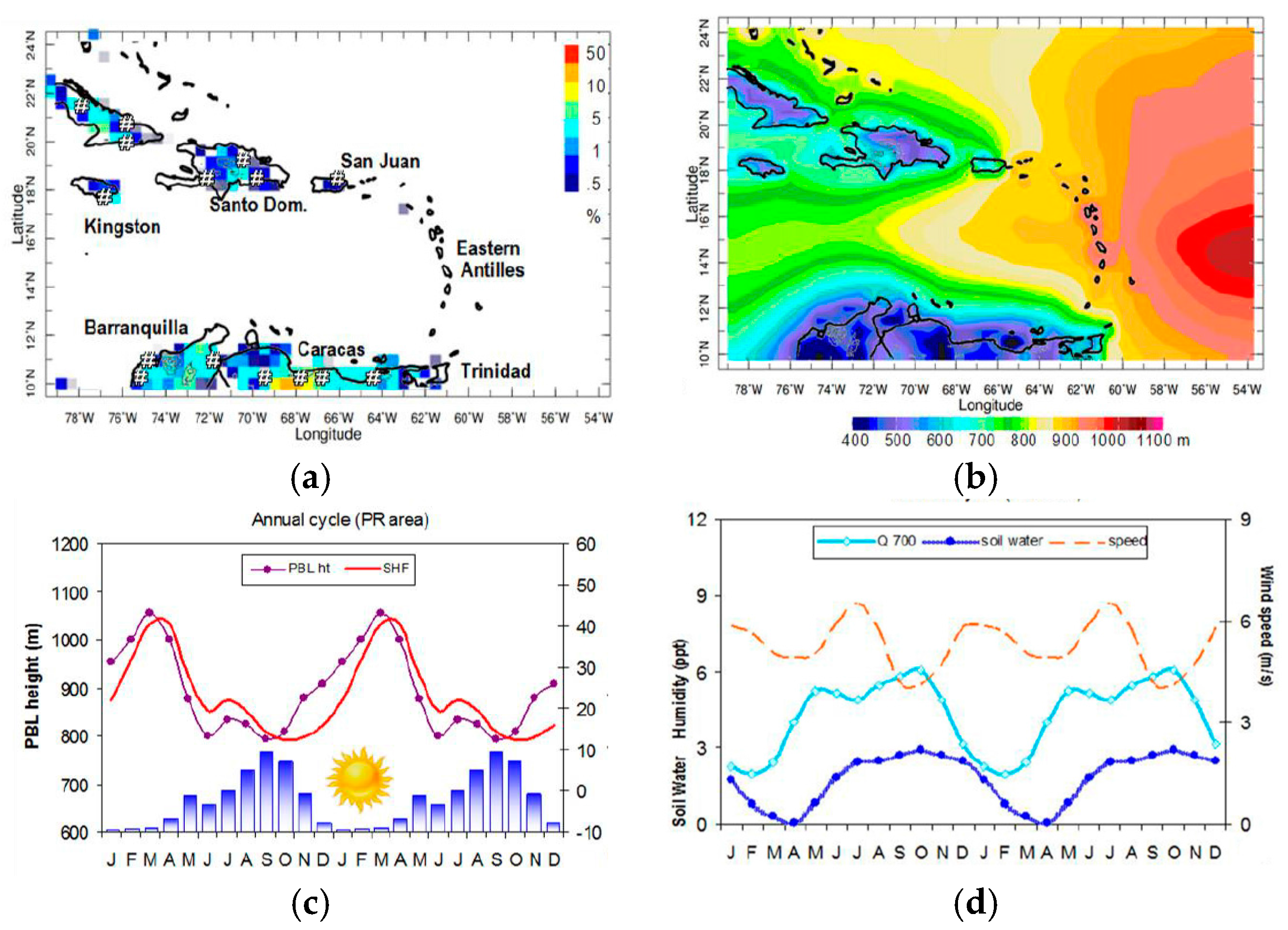

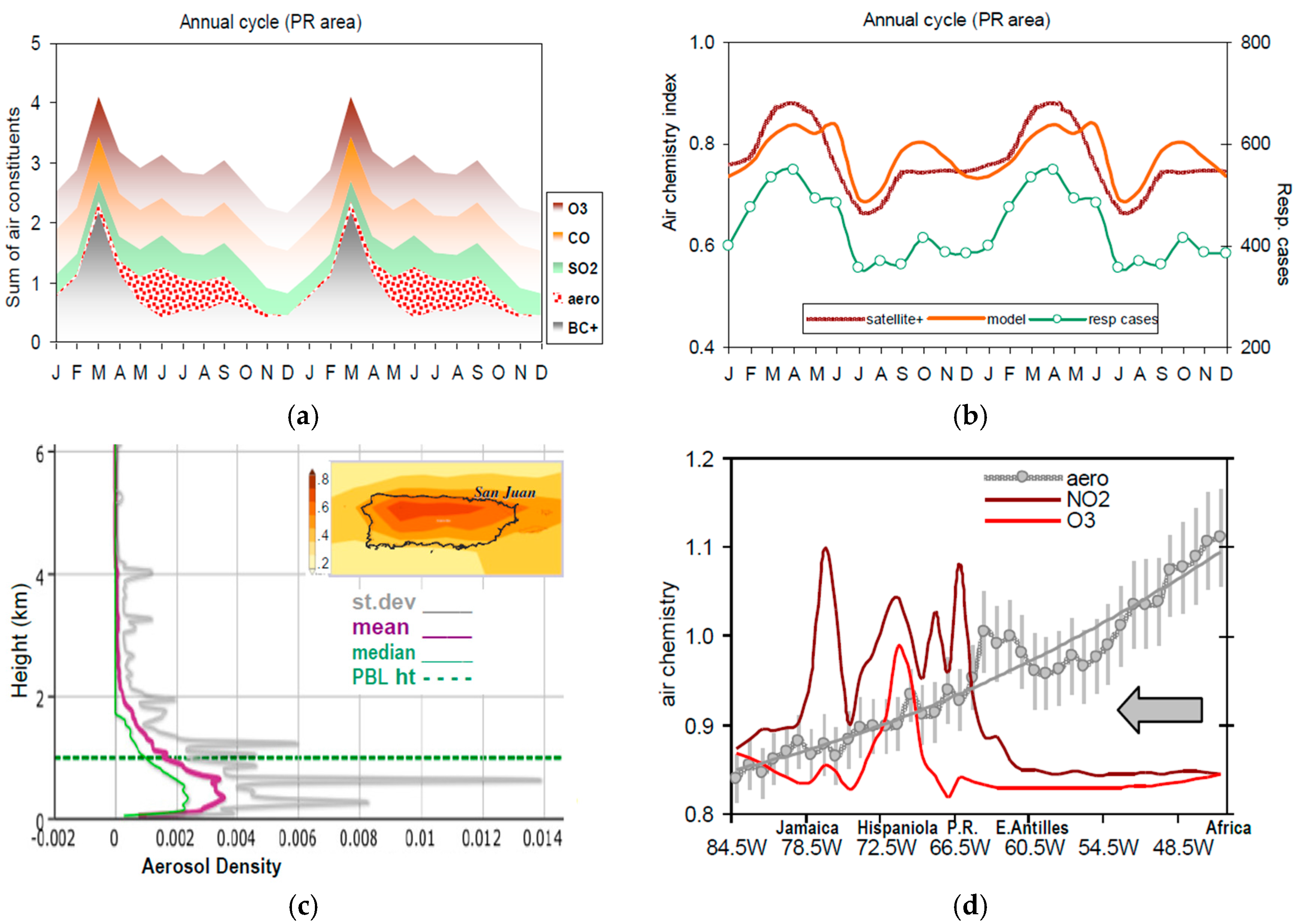

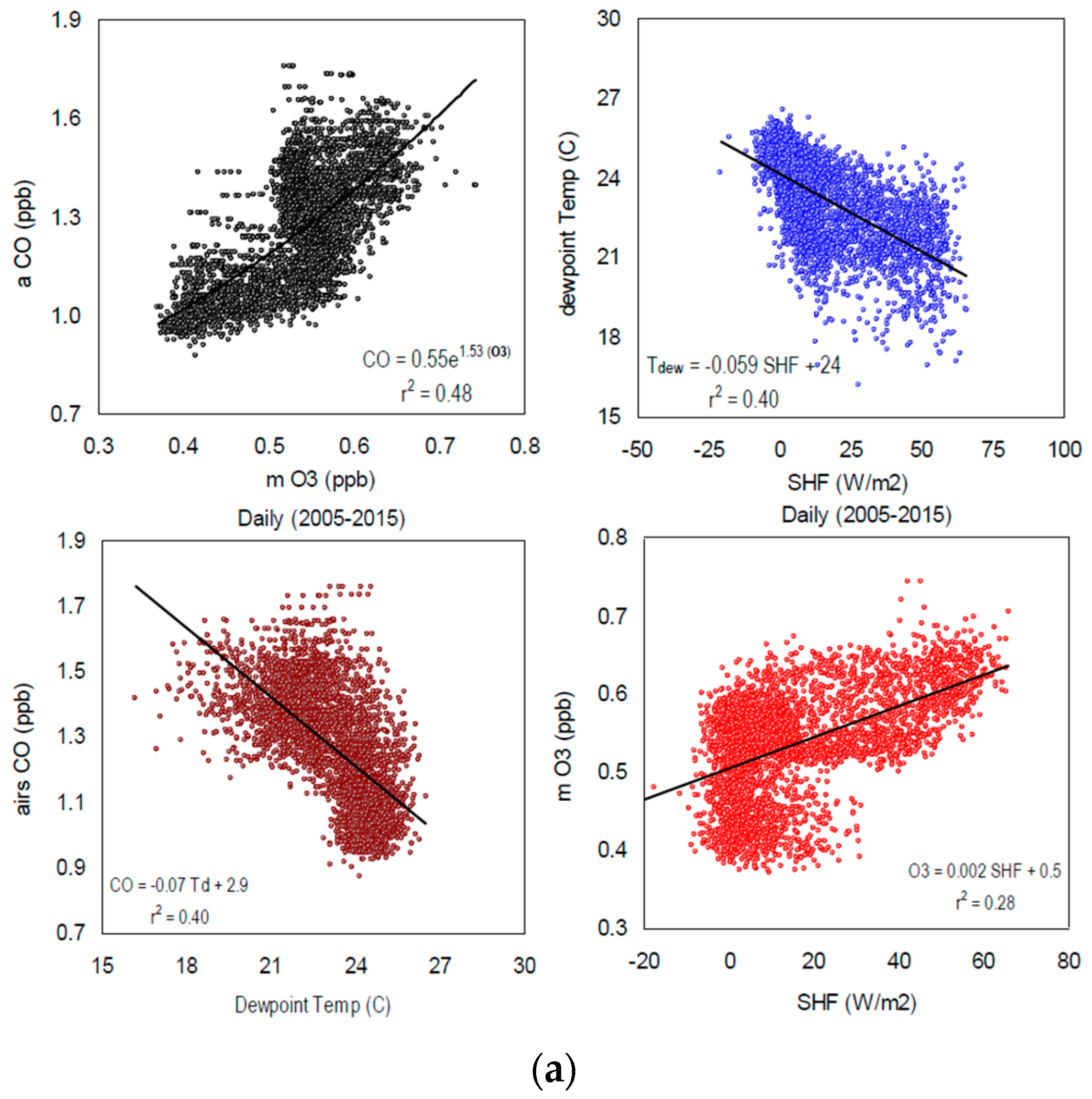

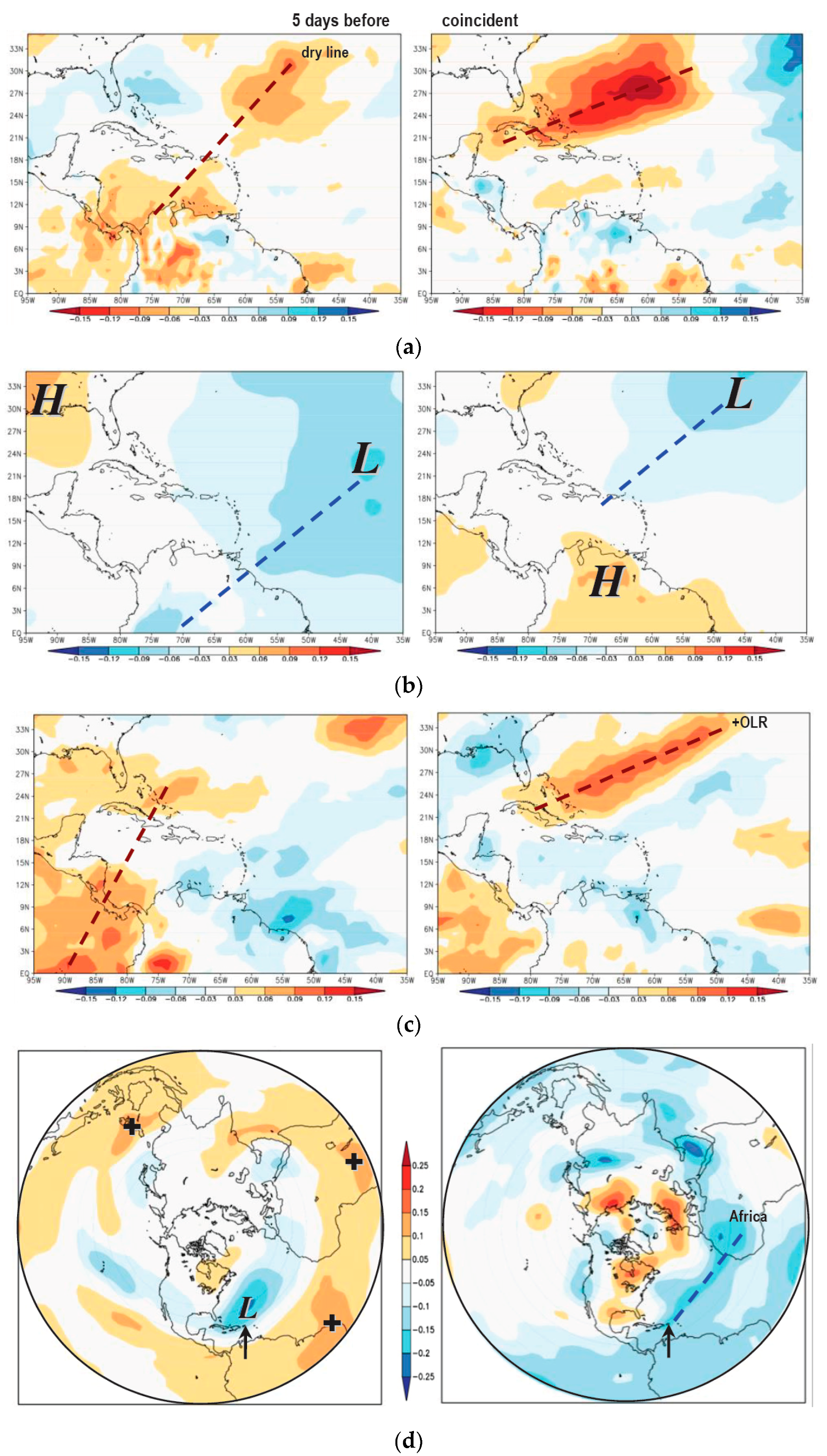
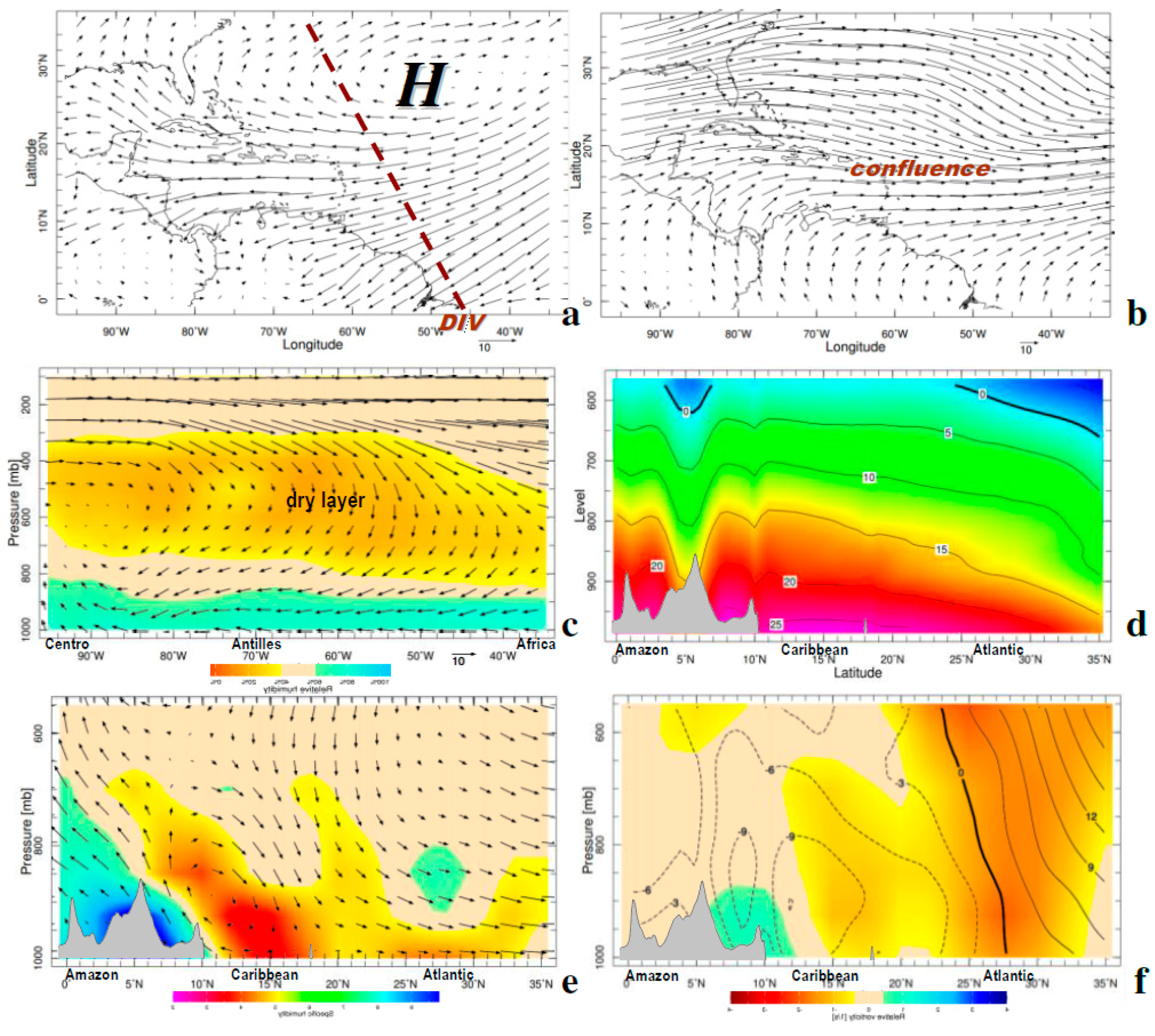

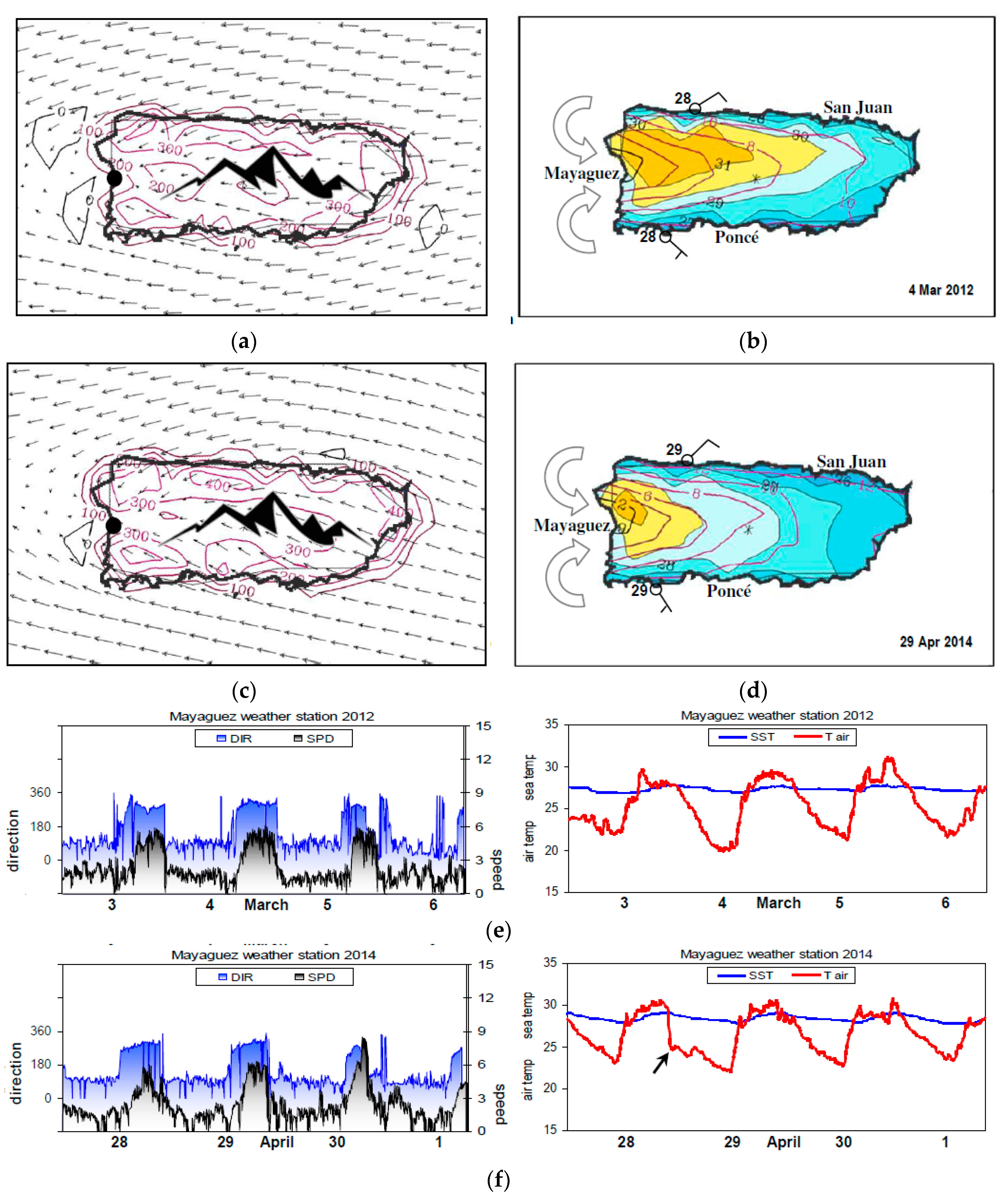
| (a) | (b) | |||
|---|---|---|---|---|
| Country | Greenhouse Gas Emissions M T/year | Population M | Sector | Percent |
| Trinidad and Tob | 57.8 | 1.36 | Energy | 52.8 |
| Cuba | 55.1 | 11.39 | Agriculture | 12.4 |
| Dominican Rep | 33.8 | 10.53 | Industry | 11.2 |
| Jamaica | 12.1 | 2.79 | Transport | 9.7 |
| Haiti | 8.7 | 10.71 | Urban | 6.3 |
| Neth. Antilles | 5.3 | 0.20 | Waste | 5.8 |
| Puerto Rico | 5.1 | 3.68 | Land use | 1.1 |
| Bahamas | 4.7 | 0.39 | Other | 0.7 |
| Guadeloupe | 2.6 | 0.47 | ||
| Martinique | 2.5 | 0.40 | ||
| Barbados | 1.4 | 0.28 | ||
| Grenada | 0.7 | 0.11 | ||
| Montserrat | 0.6 | 0.01 | ||
| Saint Lucia | 0.6 | 0.18 | ||
| Antigua and B | 0.5 | 0.09 | ||
| Cayman I | 0.4 | 0.06 | ||
| Aruba | 0.4 | 0.10 | ||
| Dominica | 0.3 | 0.07 | ||
| St Vincent and G | 0.3 | 0.11 | ||
| St Kitts and N | 0.2 | 0.06 | ||
| Anguilla | 0.1 | 0.03 | ||
| Acronym | Name | Space, Time Resolution | Quantity |
|---|---|---|---|
| AERONET | Sun photometer 0.55 μm (Parguera) | Station, daily | AOD fine fraction |
| AIRS | Atmospheric Infrared Sounder | 100 km, twice daily | CO, O3 1000–925 hPa |
| CALIPSO | Cloud-Aerosol Lidar and Infrared Pathfinder Satellite Observation | ~1 km along swath, weekly | Aerosol density profile |
| CMORPH | CPC morphed multi-satellite fields | 25 km, 3 hourly | Rainfall |
| GEOS-5 | Air chemistry data assimilation system input to MERRA2 | ~50 km, daily, monthly | Smart interpolation scheme |
| GFS | Global Forecast System, operational weather data | 50 km, 3 hourly | Forcing of HYSPLIT model |
| GRACE | Gravity Recovery and Climate Experiment | 100 km | Soil water fraction |
| HYSPLIT | Hybrid Single Particle Lagrangian Integrated Trajectory Model | ~25 km, along trajectory | Backward trajectories |
| MERRA2 | Modern Era Reanalysis for Research and Applications | ~50 km, daily, monthly | BC, O3, SO2, AOT, meteorology |
| MODIS | Moderate Imaging Spectrometer (Near-infrared sensor, λ 0.5–2.0 μm) | 100 km, twice-daily composite | Aerosol optical depth |
| NAM | North American Mesoscale weather model (WRF) | 10 km, 3 hourly | Local Meteorological fields |
| NCEP2 | National Centers for Environmental Prediction version2 reanalysis | 200 km, monthly | Regional Meteorological fields |
| NWS | National Weather Service (San Juan) | Radiosonde–twice-daily | Temp and wind profiles |
| OLR | Outgoing Longwave Radiation | 100 km, daily | Surface or cloud top infrared emission |
| OMI | Ozone Monitoring Instrument UV absorption λ 0.31–0.46 μm | 25 km, daily | tropospheric NO2, PBL SO2, AOT |
| N~4000 | Index | AOD f/c | m O3 | o NO2 | o AOT | a CO |
|---|---|---|---|---|---|---|
| AOD f/c | 0.44 | |||||
| m O3 | 0.60 | 0.27 | ||||
| o NO2 | 0.56 | 0.09 | 0.07 | |||
| o AOT | 0.39 | −0.12 | −0.04 | −0.02 | ||
| a CO | 0.61 | 0.29 | 0.68 | 0.13 | −0.04 | |
| OLR | 0.13 | 0.28 | 0.18 | 0.03 | −0.27 | 0.20 |
| Tdew | −0.37 | −0.25 | −0.50 | −0.07 | 0.19 | −0.63 |
| U wind | 0.11 | 0.33 | 0.06 | 0.03 | 0.02 | 0.06 |
| V wind | −0.07 | −0.09 | −0.15 | −0.08 | 0.17 | −0.15 |
| dT/dz | −0.19 | −0.11 | −0.31 | −0.03 | 0.14 | −0.20 |
| humidity | −0.11 | 0.03 | −0.21 | 0.01 | 0.14 | −0.27 |
| SH flux | 0.46 | 0.30 | 0.53 | 0.09 | −0.05 | 0.56 |
| evap | −0.17 | −0.21 | −0.05 | −0.06 | −0.11 | −0.13 |
© 2017 by the author. Licensee MDPI, Basel, Switzerland. This article is an open access article distributed under the terms and conditions of the Creative Commons Attribution (CC BY) license (http://creativecommons.org/licenses/by/4.0/).
Share and Cite
Jury, M.R. Caribbean Air Chemistry and Dispersion Conditions. Atmosphere 2017, 8, 151. https://doi.org/10.3390/atmos8080151
Jury MR. Caribbean Air Chemistry and Dispersion Conditions. Atmosphere. 2017; 8(8):151. https://doi.org/10.3390/atmos8080151
Chicago/Turabian StyleJury, Mark R. 2017. "Caribbean Air Chemistry and Dispersion Conditions" Atmosphere 8, no. 8: 151. https://doi.org/10.3390/atmos8080151
APA StyleJury, M. R. (2017). Caribbean Air Chemistry and Dispersion Conditions. Atmosphere, 8(8), 151. https://doi.org/10.3390/atmos8080151





